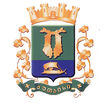Kutaisi
| Kutaisi ქუთაისი |
|||
|---|---|---|---|
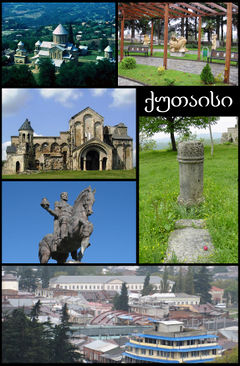 |
|||
|
|||
 Kutaisi
ქუთაისი |
|||
| Coordinates: | |||
| Country | |||
| Mkhare | Imereti | ||
| Government | |||
| - Mayor | Gia Tevdoradze | ||
| Area | |||
| - Total | 70 km2 (27 sq mi) | ||
| Population (2002) | |||
| - Total | 192,500 | ||
| Time zone | Georgian Time (UTC+4) | ||
| Website | kutaisi.gov.ge | ||
Kutaisi (Georgian: ქუთაისი; ancient names: Aea/Aia, Kutatisi, Kutaïssi) is Georgia's second largest city and the capital of the western region of Imereti. It is 221 km to the west of Tbilisi.
Contents |
Geography
Kutaisi is located along both banks of the Rioni River. The city lies at an elevation of 125–300 meters (410–984 feet) above sea level. To the east and north-east, Kutaisi is bounded by the Northern Imereti Foothills, to the north by the Samgurali Range, and to the west and the south by the Colchis Plain.
Climate
The climate in Kutaisi is humid subtropical with a well-defined on-shore/monsoonal flow (characteristic of the Colchis Plain) during the Autumn and Winter months. The summers are generally hot and relatively dry while the winters are wet and cool. Average annual temperature in the city is 14.5 degrees Celsius. January is the coldest month with an average temperature of 5.3 degrees Celsius while July is the hottest month with an average temperature of 23.2 degrees Celsius. The absolute minimum recorded temperature is -17 degrees Celsius and the absolute maximum is 44 degrees Celsius. Average annual precipitation is around 1,530 mm (60.24 in). Rain may fall in every season of the year. The city often experiences heavy, wet snowfall (snowfall of 30 cm/12 inches or more per single snowstorm is not uncommon) in the winter, but the snow cover usually does not last for more than a week. Kutaisi experiences powerful easterly winds in the summer which descend from the nearby mountains.
Landscape
Kutaisi is surrounded by deciduous forests to the northeast and the northwest. The low-lying outskirts of the city have a largely agricultural landscape. Because of the many gardens in the city centre and the high leafy trees alongside the sidewalks of its streets and boulevards, Kutaisi is painted in bright green in the spring and in yellow-red in the autumn. In the springtime, when the snow starts to melt in the nearby mountains, the storming Rioni River in the middle of the city is heard far beyond its banks.
History
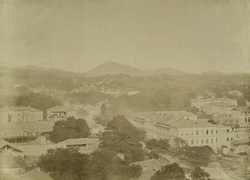
Kutaisi was the capital of the ancient Kingdom of Colchis. Archeological evidence indicates that the city functioned as the capital of the kingdom of Colchis as early as the second millennium BC. It is widely believed by historians that when Apollonius Rhodius was writing about Jason and the Argonauts and their legendary journey to Colchis, Kutaisi/Aia was the final destination of the Argonauts and the residence of King Aeëtes. From 978 to 1122 CE Kutaisi was the capital of the united Kingdom of Georgia, and from the 15th century until 1810 it was the capital of the Imeretian Kingdom. In 1508, the city was captured by Selim I, who was the son of the Sultan of the Ottomans at that time, Bayezid II.
In XVII c. Imeretian kings have many appeals to Russia to help them in their struggle for independence from the Ottomans. All claims were ignored as Russia did not want to spoil relations with Turkey. Only in a reign of Ekaterina II in 1768 troops of general Gottlieb Heinrich Totleben were sent to join forces of King Heraclius II of Georgia who hoped to reconquer the Ottoman-held southern Georgian lands in conjunction with Russia. Totleben helped King Solomon I of Imereti recover his capital Kutaisi on August 6, 1770.
Finally Russian-Turkish wars ended with annexion in 1810 of the Imeretian Kingdom with Russian Empire. The city was the capital of the Gubernia of Kutaisi, which included much of west Georgia. In March 1879, the city was the site of a blood libel trial that attracted attention all over Russia; the ten accused Jews were acquitted.[1]
Before Georgia's independence in 1991, followed by the country's economic collapse, Kutaisi was a major industrial center. Today, many inhabitants of the city have had to leave and work abroad. Small-scale trade prevails among the rest of the population.
The city had a massive Soviet war memorial for the Georgians killed in World War II. On December 18, 2009, a private demolition company working for the Georgian government demolished the monument to make way for a parliament building, despite massive protest from Russia and Georgian opposition politicians. Safety regulations were violated, resulting in flying chunks of concrete hitting civilian population centers. A woman and her daughter were killed in the courtyard of their home, and four other people were critically wounded.[2]
Education and Science
Kutaisi is one of the most important educational and scientific centers in Georgia, hosting the Gelati Academy of Sciences, established in the 12th century by King David IV. Here is also one of the most important educational centers in modern Georgia, Ak'ak'i Ts'ereteli State University, established in 1930. Besides these two, there are many other universities, institutes, colleges and schools in Kutaisi.
Culture
Kutaisi has an ancient cultural tradition. Here is a list of the cultural centers in Kutaisi.

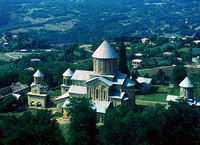
Museums, Archive, Library, Gallery, Art Salon:
1. Kutaisi State Historical Museum
2. Kutaisi Museum of Sport
3. Kutaisi Museum of Martial Art
4.Museum of Zakaria Paliashvili
5.Kutaisi State Historical Archive
6. Kutaisi State Scientific-Universal Library
7. David Kakabadze Fine Art Gallery
8. Art Salon
Theatres, Cinema and Entertaining Center:
1. Kutaisi Lado Meskhishvili State Academic Theatre
2. Kutaisi Meliton Balanchivadze State Opera House
3. Kutaisi Iakob Gogebashvili State Puppet Theatre
4. Cinema and Entertaining Center “Suliko”
5. Hermann-Wedekind-Jugendtheater
Professional Unions and Public Organizations:
1. Georgian Writers’ Union
2. Georgian Painters’ Union
3. Folk Palace
Media:
Local Newspapers: “Kutaisi”, “Imeretis Moabe”, “PS”, “Akhali Gazeti”, "Kutaisuri Versia", "Chveneburebi" (Journal); Scientific Journal “Gantiadi”.
TV: "Rioni"; Radio: "Dzveli Kalaki" (old City)
Also all the republican newspapers, journals and television stations have their representatives in Kutaisi.
Sport
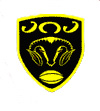
Kutaisi has a great tradition in sports, with many famous sport clubs. FC Torpedo Kutaisi has participated on the highest level of the Soviet Union football league. After Georgia achieved independence, it won many domestic and international titles. RC AIA Kutaisi won the Soviet Championship several times in rugby, and after independence, national championships and cups. Kutaisi also had an influential basketball club.

Main sights
The landmark of the city is the ruined Bagrati Cathedral, built by Bagrat III, king of Georgia, in the early 11th century. The Bagrati Cathedral, and the Gelati Monastery a few km east of the city, are UNESCO World Heritage Sites. One of the famous churches in Georgia is Motsameta Church. It is named after two saints, brothers David and Constantine. They were the Dukes of Margveti, and were martyred by Arab invaders in the 8th century. Besides the churches, there are many interesesting places in Kutaisi, such as: Sataplia Cave, where one can observe footprints of Dinosaurs; Geguti Palace, which was one of the residences of Georgian monarchs; "Okros Chardakhi" – Georgian Kings’ Palace; and the Pantheon, where many notable citizens are buried.
In December 2009, the demolition (using explosives) of a major war memorial in the city killed two people due to insufficient security around the demolition site. Russia also criticised the decision to remove the war memorial.[3]
Economy
On April 2, 2009, the Georgian economy minister, Lasha Zhvania, announced that an Egypt-based home appliances producer company, Fresh Electric, intends to create a free industrial zone in Kutaisi.[4]
Notable native sons and daughters
- Aeëtes - King of kingdom of Colchis
- Bagrat III - King of united Kingdom of Georgia in 975-1014
- Giorgi I - King of united Kingdom of Georgia in 1014-1027
- Bagrat IV - King of united Kingdom of Georgia in 1027-1072
- Giorgi II - King of united Kingdom of Georgia in 1072-1089
- David IV - King of united Kingdom of Georgia in 1089-1125
- Veriko Anjaparidze - Georgian actress
- Ak'ak'i Vasadze - Georgian actor
- Teimuraz Apkhazava - World and European champion in Wrestling
- Revaz Gabriadze - cinematographer, writer, director, production designer
- Niko Nikoladze (1843–1928) - Georgian public figure
- Meliton Balanchivadze (1862–1937) - Georgian composer
- Zakaria Paliashvili (1871–1933) - Georgian composer
- Iakob Nikoladze (1876–1951) - Georgian sculptor, designer of the previous state flag of Georgia.
- Władysław Raczkiewicz (1885–1947) - first president of the Polish government-in-exile, 1939–1947
- Joseph Orbeli (1887–1961) - orientalist
- David Kakabadze (1889–1952) - Georgian painter
- Otar Korkiya (1923–2005) - Georgian basketball player, European Champions' Cup champion and Olympic silver medalist
- Dodo Chichinadze (1924–2009) - Georgian actress
- Revaz Dzodzuashvili (b. 1945) - Georgian football player, winner of the Bronze Medal of the World Cup 1966
- Zurab Sakandelidze (b. 1945) - Georgian basketball player, Olympic champion
- Mikheil Korkiya (b. 1948) - Georgian basketball player, Olympic champion
- Meir Pichhadze (1955–2010) - Israeli painter, Kutaisi native
- Tengiz Sulakvelidze (b. 1956) -Georgian football player, played in 1982 FIFA World Cup
- Maia Chiburdanidze (b. 1961) - the seventh Women's World Chess Champion
- Nino Burjanadze (b. 1964) - former Speaker of Georgian Parliament
- David Khakhaleishvili (b.1971) - Olympic champion in Wrestling
- Katie Melua (b. 1984) - singer
International relations
Twin towns — Sister cities
Kutaisi is twinned with:
|
|
See also
- Colchis
- Imereti
- Georgia
- History of Georgia
- Culture of Georgia
References
- ↑ Effie Ambler, Russian Journalism and Politics: The Career of Aleksei S. Suvorin, 1861-1881 (Detroit: Wayne State University Press, 1972: ISBN 0-8143-1461-9), p. 172.
- ↑ http://www.washingtonpost.com/wp-dyn/content/article/2009/12/19/AR2009121901006.html
- ↑ Woman, her daughter killed during war memorial demolition in Kutaisi Dez, 19, 2009 09:41 - Itar-Tass (Russia)
- ↑ Egypt-based Company Plans Free Industrial Zone in Kutaisi. Civil Georgia. April 2, 2009
External links
- http://www.qutaiso.ge/
- http://www.Easy.ge/
- http://GeCoders.com/
- http://www.kutaisi.com.ge/
- http://www.kutaisi.org/
- http://www.nkta.org/
- http://www.knia.ge/
- http://www.kutaisi.ucoz.com/
- http://www.imereti.com/
- http://www.kutaisi.ge/
- http://www.infokutaisi.com/
|
|||||||
.jpg) |
Historic capitals of Georgia | ||||||
|---|---|---|---|---|---|---|---|
|
Mtskheta · Tbilisi · Kutaisi |
|||||||
|
|||||||||||||||||||||||||||||||||||

